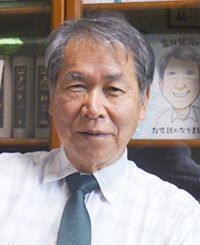What You Don’t Know About Iran
Is Iran A Dangerous Country?
(photo: Reuters/Aflo)
The Iran situation is getting critical. The U.S. is imposing severe economic sanctions on Iran thinking it to be a satanic country. The Western world seems to think that the 1979 Revolution turned Iran into a totalitarian country. But is our understanding of the Iranian Revolution correct? What was the driving force behind it?
“We don’t need Middle Eastern Oil & Gas, & in fact have very few tankers there, but will help our Allies!” said President Trump in a tweet on 16 September, right after Saudi Arabia’s oil infrastructure was attacked.
But we have yet to find the culprit (at the time of writing, 17 October). Trump has blamed Iran without proof and imposed maximum sanctions in a bid to quickly establish an encirclement network. Iranian President Hassan Rouhani has responded saying that this is economic terrorism.
Historically, the U.S. has always mistrusted Iran. This is because Iran’s westernization was foiled by the Iranian Revolution of 1979, and it officially became the Islamic Republic of Iran. The U.S. thinks that the Revolution turned Iran into a country deprived of freedom. But is this true?
The Liberty Magazine interviewed experts on the Iranian Revolution and the political situation that followed.
Photograph: 26th September, President Rouhani speaks at the UN.
A still image from the 1979 documentary film “For Liberty” about the Revolution, directed by Hossein Torabi.
Interview
The Iranian Revolution Aimed to Create a Virtuous Society
Biography
Kenji Tomita

Former Professor at the Faculty of Religious Studies, Doshisha University
Tomita was born in 1947 in Ehime Prefecture, Japan. After completing his Masters degree in Eastern Philosophy at Ritsumeikan University, he went to the University of Tehran to further his studies. In 2018, he retired from his professorship in Religious Studies at Doshisha University. He specializes in Iran studies. He has numerous publications in Japanese.
–What was the aim of the Iranian Revolution?
Tomita: Ayatollah Khomeini (1902-89), who was the spiritual pillar of the Revolution, championed three flags.
The first was “overthrow the monarch”. Before 1979, the Pahlavi dynasty ruled the people. This dynasty was a puppet dynasty that the U.S. reinstated during the Cold War when they feared that Iran might fall under the influence of Soviet Russia.
The second was “the revival of religion (Islam)”. The Pahlavi dynasty thought that modernization meant westernization and secularization, so they planned to oust Islam. This, however, resulted in moral degeneration amongst the people.
That was why Ayatollah Khomeini tried to establish a country governed by a Muslim scholar (Ulama). This is based on Plato’s idea of the philosopher king, which he outlines in The Republic. In other words, he wanted the country to be governed by the sense of justice that comes from a virtuous religious leader.
The third flag was “anti-Israel”. Ayatollah Khomeini said that the founding of Israel was a misfortune, and saw that the tragedy that befell the Palestinians will spread to other nations.
The founding of Israel in 1948 marked the beginning of a major conflict between Israel and the Arabs. Seeing this, the U.S. planned to establish a puppet government in the Persian country of Iran to make it support Israel against the Arab nations. Ayatollah Khomeini resisted this idea.
Since before the Revolution, Ayatollah Khomeini had been accusing the monarch of being a puppet to the U.S., and that the U.S. was trying to destroy Islam. He had very keen foresight.
An Affinity With Catholicism
–What was Ayatollah Khomeini’s philosophy?
Tomita: At the root of Ayatollah Khomeini’s philosophy was a Hellenism-inspired vision of a rational but mystical Islam.
Monotheistic religions such as Judaism, Christianity and Islam tend to separate the Creator from the Created. In contrast Sufism (mystically-oriented Islam) thinks of God like a lake, and that all existence is like the water that comes from the lake.
This is very similar to the Buddhist idea of Buddha-nature. There is also a close affinity between Islam’s largest branch, Shia Islam, and Catholicism. So much so that the Iranian government has been sending a Goodwill ambassador to the Vatican since the Revolution.
Shia Islam places great importance on human reason and judgment, which gives it the flexibility to reinterpret the teachings according to the changing times.
In contrast, the purist Wahhabism that spread in Saudi Arabia disregards human reason and judgment, and makes literal interpretation of religious texts. This fundamentalism is the root of their oppressive government.
Iran Unified Religion With Politics
–What sort of country did the Iranian Revolution aim to create?
Tomita: It aimed to create a virtuous society based on Islam. A materialistic country cannot understand what virtue is, because virtue means being closer to God. That’s why the Supreme Leader, who is selected from among the highest religious clerics, makes an effort to stop the country from becoming materialistic. The Supreme Leader is like a shepherd who protects the people.
Ayatollah Khomeini said that, in order to create a virtuous society, there is a need for an expert in Islamic law to govern the country. He rejected the idea of separating religion and state, and instead established a government that was in charge of making both political and religious decisions.
A Higher Vision
–This unification of religion and politics is the reason why the U.S. thinks Iran is a dictatorship.
Tomita: But even the Supreme Leader is bound by religious laws, so he cannot be a dictator.
Of course, whether the theocracy works is largely up to the Supreme Leader’s character. Ayatollah Khomeini tried to balance the opposing Principlist (Conservative) and Reformist forces, but the second Supreme Leader, Ayatollah Khamanei tends to lean towards the Principlists.
It is true that there are many social issues in Iran that are yet to be resolved. But they are currently experimenting with creating a virtuous society. Of course we need to assess whether the experiment is going well or not. But a country like Japan, that has no higher vision, still has much to learn from Iran.



















